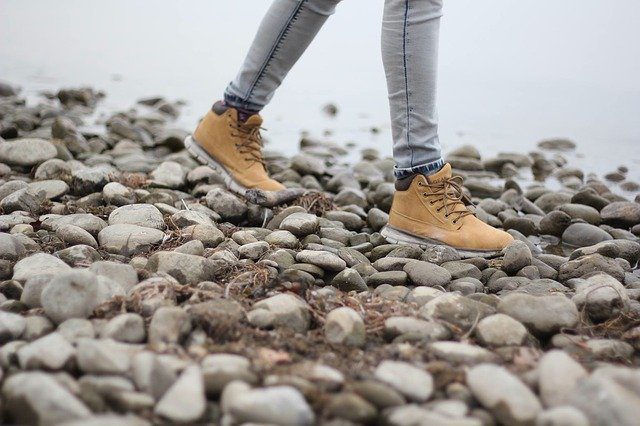articles
3 Criteria For Choosing The Right Hiking Boots
When walking, hiking, trekking, approaching, or even mountaineering, shoes remain the basic element, a real interface between our body and the terrain. A hiking shoe doesn’t have to go hand in hand with pain and discomfort, on the contrary! A shoe must be comfortable for the use you have of it and that requires choosing the right one, taking into account different selection criteria.
Criteria 1 – Your Practice
Day walking, approach, and hiking shoes.
For hiking, approach walking, light trekking (1 to 3 days), or even via Ferrata, we recommend shoes with an intermediate (or mid) upper with flexible upper or shoes with a low upper. Why? Because of their comfort, their lightness and their flexibility are unmatched. But first of all, a little reminder: medium shoes with a soft upper and low shoes are not just sneakers. They are generally equipped with a suitable sole (Vibram type), reinforcements, stone guards, sometimes with an impermeable membrane, etc., in short, enough to survey already very rough terrain.
We will also insist on using walking sticks when wearing low shoes or mid shoes with a flexible upper: propulsion on the ascent, distribution of the weight of the backpack, additional support points on the descent, assistance in equilibrium, they only have advantages.
Trekking and long-distance hiking shoes
During your treks and long hikes, you will inevitably cross very varied terrain. For this practice, therefore, performance shoes are needed in all situations. Obviously, high-stem trekking shoes are also more rigid and robust because they will be used more than for short hikes.
The main role of trekking shoes is to protect your feet in any situation, so they are equipped with a front stone guard, a reinforced heel, and side protectors to effectively and durably protect you from stones and roots.
Finally, the high upper protects your ankles especially when you have to carry a heavy bag for several days.
Mountaineering shoes
If your activity consists of mountaineering, and/or carrying a 20kg bag for 3 weeks, and/or walking in 20cm of fresh snow, then you will have to opt for particularly rigid mountaineering boots, often equipped with insulation, a waterproof membrane and of course a crampon compatible sole.
Winter hiking boots
In winter, what could be more beautiful than a hike in the snow with snowshoes or simply a hike in cold weather? For this, you need hiking boots dedicated to winter use with a warm lining.
Unlike snow boots, winter hiking shoes are made for walking with a perfect roll and very good support of the foot. No more loose heels during your snowshoe outings!
Criteria 2 – Stem Height
Hiking sandals (without upper)
Perfectly suited for travel or hiking in hot and humid conditions, hiking sandals are particularly popular. They offer unparalleled breathability with nevertheless real hiking soles allowing excellent grip.
Some offer a front stone guard while others fully play the card of the comfort of sandals.
High-top shoes
High-top shoes are certainly heavier than low-cut shoes but have the advantage of better protecting your ankles during your hikes. They protect against shocks of course with the multiple obstacles that are roots, branches, or stones but above all, they offer increased ankle support to avoid twisting the ankles.
Medium or “mid” shoes
The Medium Stem shoes also called mid is just intermediate between the low and high shoes rod shoes. They are lightweight while providing superior support for low-cut shoes. They are particularly appreciated for short or medium hikes.
Criterion 3 – Your Feet
The shoe is obviously to be chosen according to your foot morphology, at the risk of contracting blisters and pain when walking. If we frequently (not to say all the time) have blisters, it is because:
- the shoe is not suitable
- the size is not suitable
- the socks are not suitable
- the soles are not suitable
- and as a last resort, that your foot is not suitable
In many cases, simply using soft upper mid shoes or low shoes rather than tall, stiff shoes greatly reduces the risk of blisters.
Choosing the size of your hiking boots is sometimes a difficult art. In any case, on the climb, our heel must not (too) take off. And on the descent, it’s our kick that must stop the foot, and not the toes …
Blisters can also be caused by socks that are too hot, especially in summer. Let’s not forget that our feet get hot during a hike and that they tend to swell. Depriving your foot of good breathing/ventilation is to take the risk of contracting blisters. Let’s not hesitate to have at least two pairs of socks in our closets: one pair for winter (high and warm), and one pair for summer (light and breathable).
A foot in the wrong position in a shoe is sure to cause blisters and even pain in the foot, knee, pelvis, or back. The feet are the basis. However, if the base is not perfectly stable, it is the organs above which will have to compensate for this lack of stability.
Shop Hiking shoes from RAXShoes.com and get 20% OFF on your first order. Use coupon “NEWRAX” at checkout.

